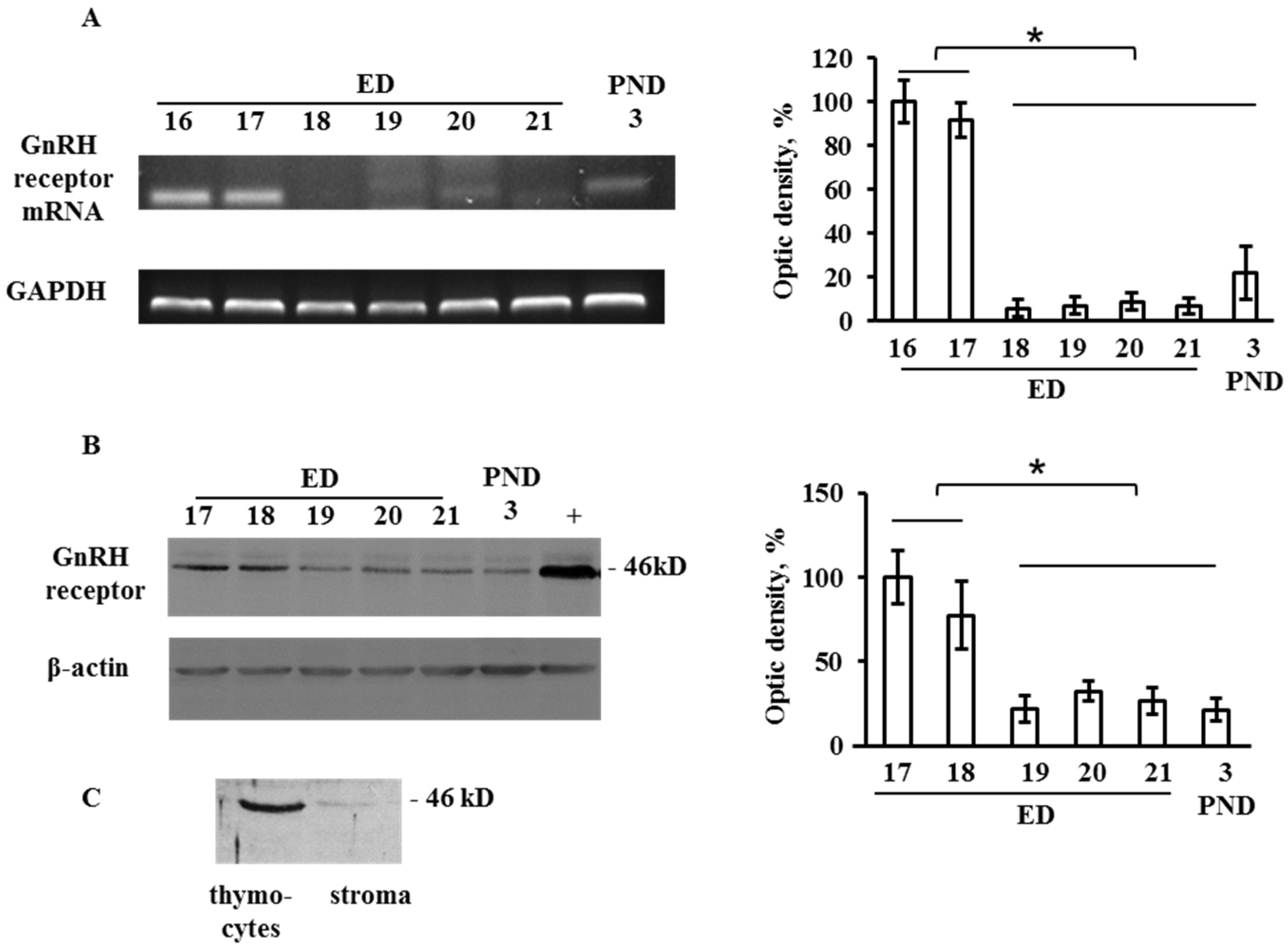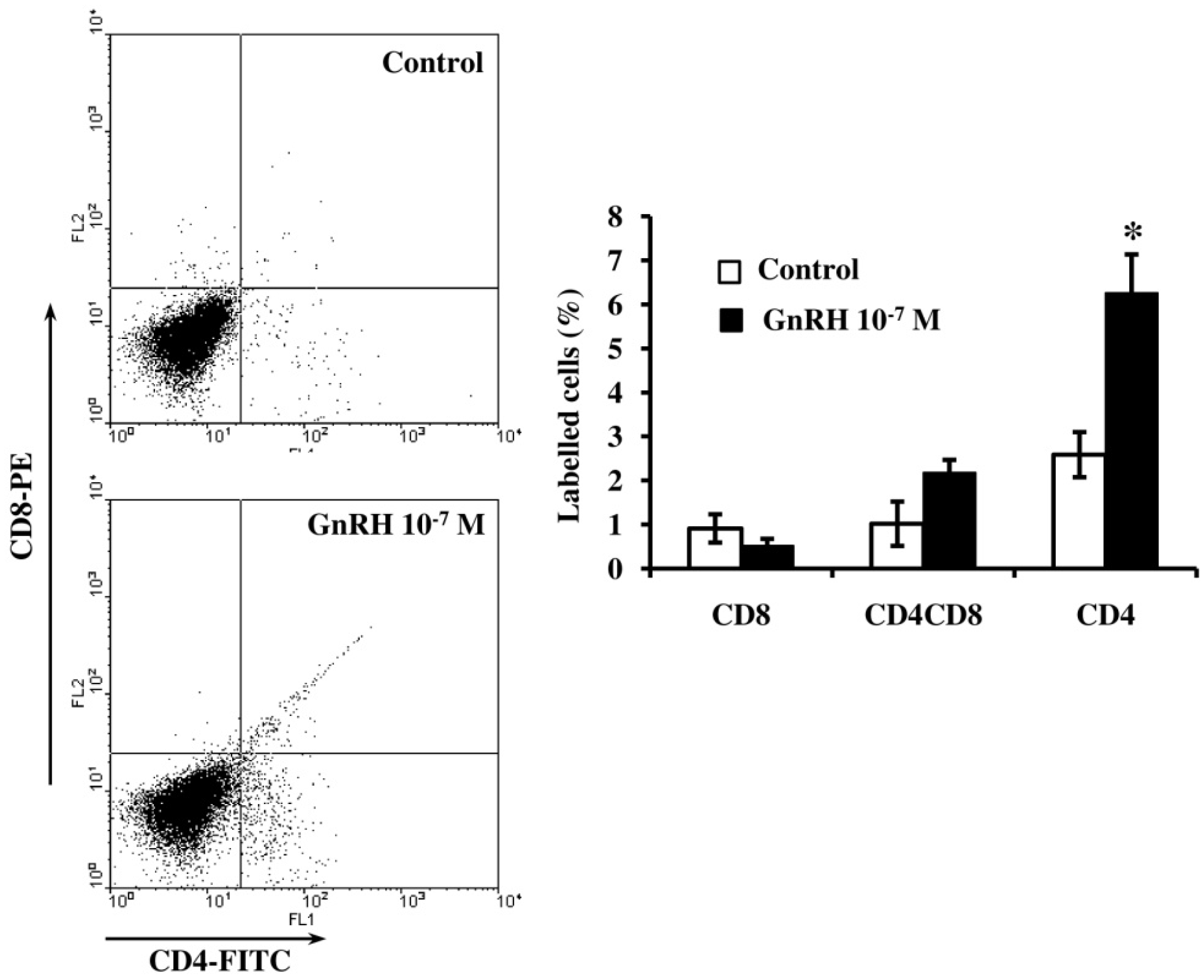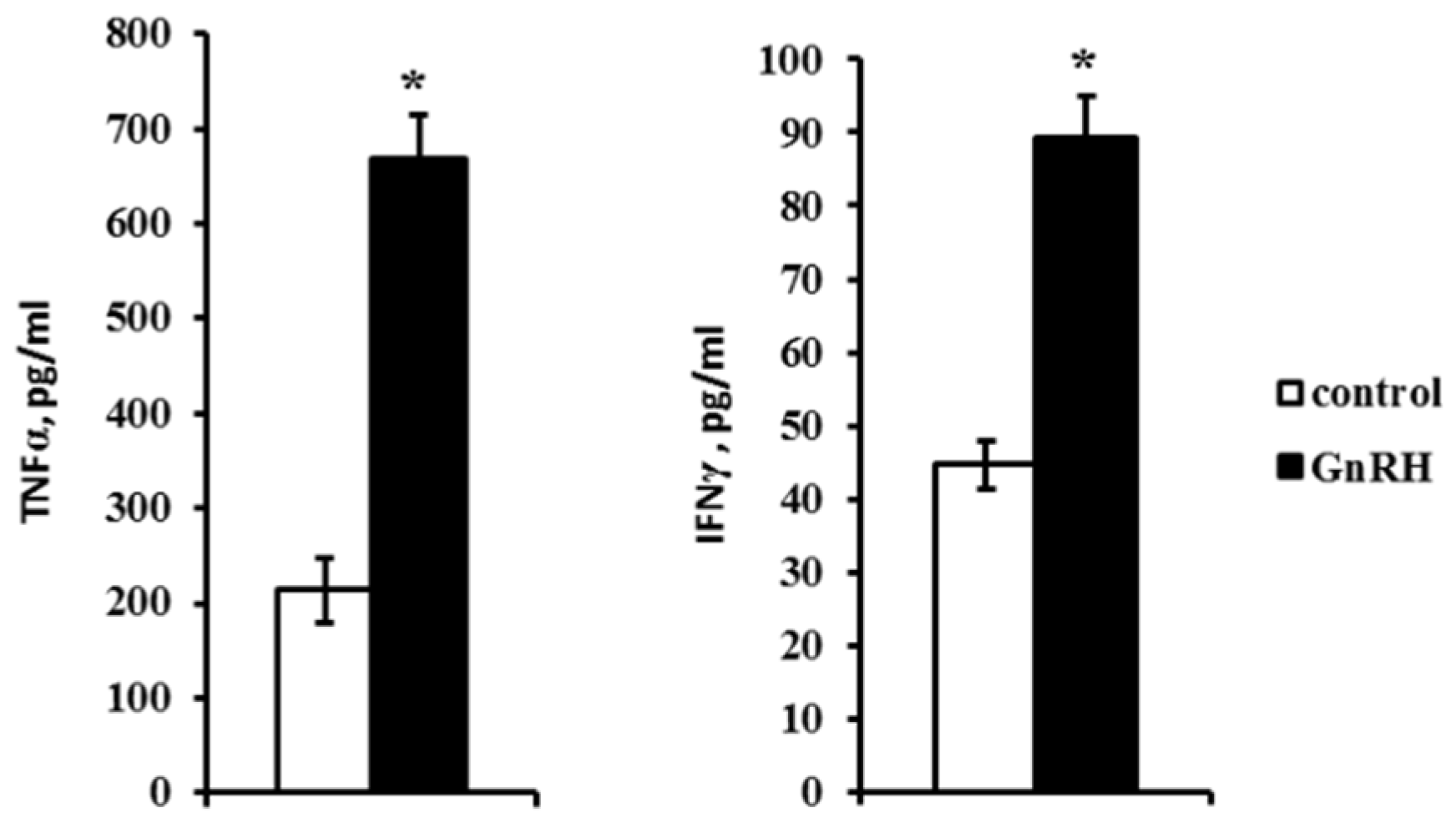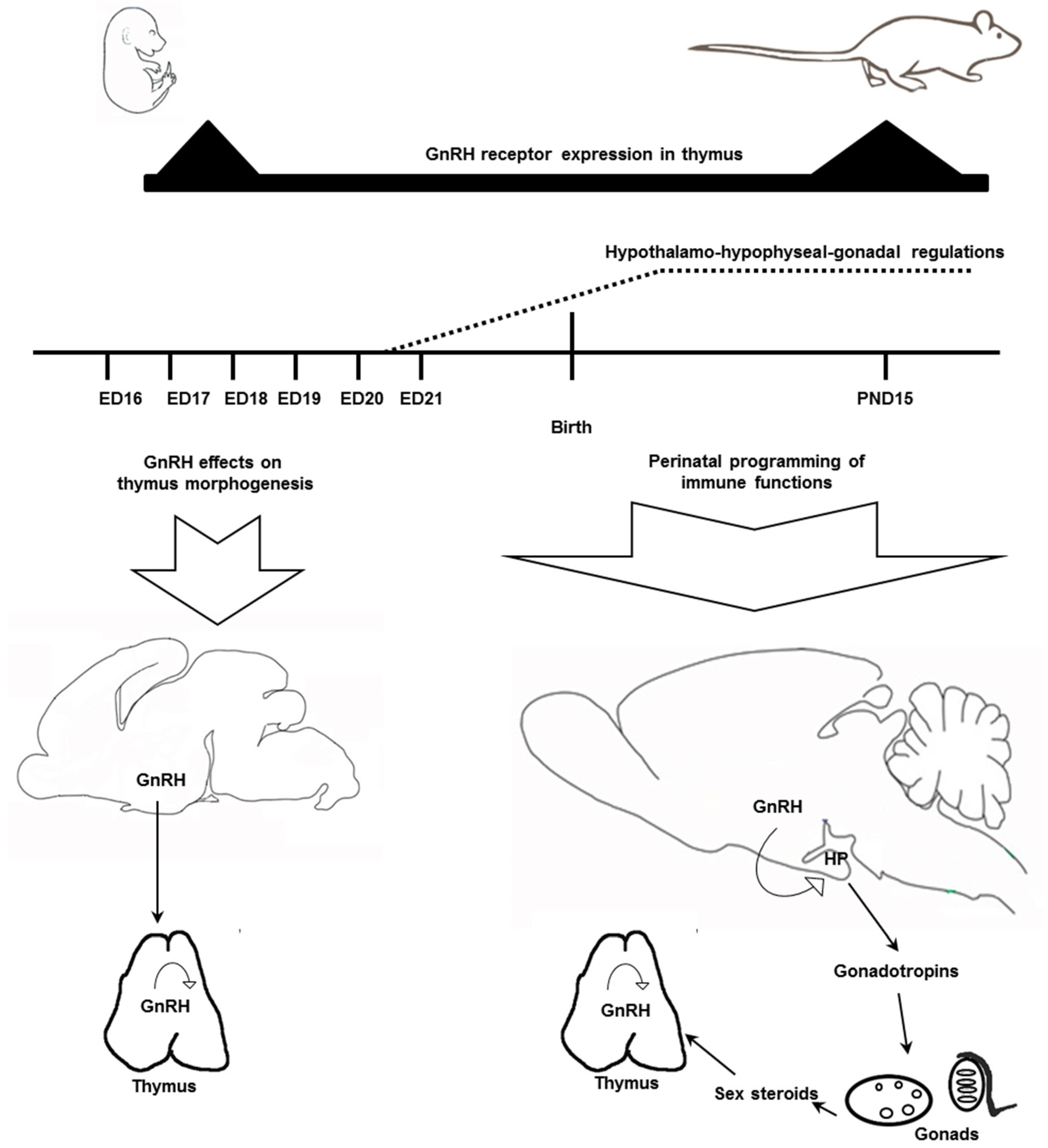Gonadotropin-Releasing Hormone in Regulation of Thymic Development in Rats: Profile of Thymic Cytokines
Abstract
1. Introduction
2. Results
2.1. GnRH Receptor Expression in the Developing Thymus
2.2. Long-Term Effects of GnGH Receptor Blockade in Rat Fetuses
2.3. GnRH Influence on T Lymphocyte Differentiation in Organotypic Culture of Fetal Thymus
2.4. GnRH Influence on Synthesis and Secretion of Cytokines in Fetal Thymus
3. Discussion
4. Materials and Methods
4.1. Animals and Experimental Design
4.2. Cell Preparation and Con A-Induced Proliferation Assay
4.3. Western Blot Analysis of GnRH Receptor Expression in Thymus
4.4. Evaluation of GnRH Influence on the Numbers of CD4+, CD8+, and CD4+CD8+ T Cells in Fetal Thymus Organotypic Culture
4.5. Evaluation of GnRH Influence on the Synthesis and Secretion of Cytokines
4.6. Cytokine Assay by Cytometric Bead Array
4.7. RNA Extraction and RT-PCR Analysis
4.8. Statistical Analysis
5. Conclusions
Author Contributions
Funding
Acknowledgments
Conflicts of Interest
Abbreviations
| CBA | cytometric bead array |
| Con A | concanavalin A |
| ED | embryonic day |
| GAPDH | glyceraldehyde-3-phosphate dehydrogenase |
| GnRH | gonadotropin-releasing hormone |
| GnRH-ant | GnRH receptor antagonist |
| HPG | hypothalamic-pituitary-gonadal |
| IFNγ | interferon γ |
| IL | interleukin |
| PND | postnatal day |
| RT-PCR | reverse transcription-polymerase chain reaction |
| TNFα | tumor necrosis factor α |
References
- Tomaszewska-Zaremba, D.; Herman, A. The role of immunological system in the regulation of gonadoliberin and gonadotropin secretion. Reprod. Biol. 2009, 9, 11–23. [Google Scholar] [CrossRef]
- Zakharova, L.A.; Izvolskaia, M.S. Interactions between the reproductive and immune systems during ontogenesis: The role of GnRH, sex steroids and immunomediators. In Sex steroids; Kahn, S.M., Ed.; InTech: Rijeka, Croatia; London, UK, 2012; pp. 341–370. [Google Scholar]
- Quintanar, J.L.; Guzmán-Soto, I. Hypothalamic neurohormones and immune responses. Front. Integr. Neurosc. 2013, 7, 56. [Google Scholar] [CrossRef] [PubMed]
- Azad, N.; LaPaglia, N.; Agrawal, L.; Steiner, J.; Uddin, S.; Williams, D.W.; Lawrence, A.M.; Emanuele, N.V. The role of gonadectomy and testosterone replacement on thymic luteinizing hormone-releasing hormone production. J. Endocrinol. 1998, 158, 229–235. [Google Scholar] [CrossRef] [PubMed]
- Jacobson, J.D.; Crofford, L.J.; Sun, L.; Wilder, R.L. Cyclical expression of GnRH and GnRH receptor mRNA in lymphoid organs. Neuroendocrinology 1998, 67, 117–125. [Google Scholar] [CrossRef] [PubMed]
- Tanriverdi, F.; Silveira, L.F.G.; MacColl, G.S.; Bouloux, P.M.G. The hypothalamic–pituitary–gonadal axis: Immune function and autoimmunity. J. Endocrinol. 2003, 176, 293–304. [Google Scholar] [CrossRef] [PubMed]
- Levite, M. Neurotransmitters activate T-cells and elicit crucial functions via neurotransmitter receptors. Curr. Opin. Pharmacol. 2008, 8, 460–471. [Google Scholar] [CrossRef]
- Ugrumov, M.V.; Sapronova, A.Y.; Melnikova, V.I.; Proshlyakova, E.V.; Adamskaya, E.I.; Lavrentieva, A.V.; Nasirova, D.I.; Babichev, V.N. Brain is an important source of GnRH in general circulation in the rat during prenatal and early postnatal ontogenesis. Comp. Biochem. Physiol. A Mol. Integr. Physiol. 2005, 141, 271–279. [Google Scholar] [CrossRef]
- Zakharova, L.A.; Ermilova, I.Y.; Melnikova, V.I.; Malyukova, I.V.; Adamskaya, E.I. Hypothalamic control of the cell-mediated immunity and of the Luteinizing Hormone-Releasing Hormone level in thymus and peripheral blood of rat fetuses. Neuroimmunomodulation 2005, 12, 85–91. [Google Scholar] [CrossRef]
- Morale, M.C.; Batticane, N.; Bartoloni, G.; Guarcello, V.; Farinella, Z.; Galasso, M.G.; Marchetti, B. Blocade of central and peripheral luteinizing hormone-releasing hormone (LHRH) receptors in neonatal rats with a potent LHRH-antagonist inhibits the morphofunctional development of the thymus and maturation of the cell-mediated and humoral immune responses. Endocrinology 1991, 128, 1073–1085. [Google Scholar] [CrossRef]
- Zakharova, L.A.; Malyukova, I.V.; Proshlyakova, E.V.; Sapronova, A.Y.; Ugrumov, M.V. Hypothalamo-pituitary control of the cell-mediated immunity in rat embryos: Role of LHRH in regulation of lymphocyte proliferation. J. Reprod. Immunol. 2000, 47, 17–32. [Google Scholar] [CrossRef]
- Mann, D.R.; Akinbami, M.A.; Lunn, S.F.; Fraser, H.M.; Gould, K.G.; Ansari, A.A. Endocrine-immune interaction: Alteractions in immune function resulting from neonatal treatment with a GnRH antagonist and seasonality in male primates. Am. J. Reprod. Immunol. 2000, 44, 30–40. [Google Scholar] [CrossRef]
- Huhtaniemi, I. Molecular aspects of the ontogeny of the pituitary-gonadal axis. Reprod. Fertil. Dev. 1995, 7, 1025–1035. [Google Scholar] [CrossRef]
- Dygalo, N.N.; Shemenkova, T.V.; Kalinina, T.S.; Shishkina, G.T. A critical point of male gonad development: Neuroendocrine correlates of accelerated testicular growth in rats during early life. PLoS ONE 2014, 9, e93007. [Google Scholar] [CrossRef]
- Marchetti, B.; Guarcello, V.; Morale, M.C.; Bartolini, G.; Raiti, F.; Palumbo, G.; Farinella, Z.; Cordaro, S.; Scapagnini, U. LHRH agonist restoration of age associated decline of thymus weight, thymic LHRH receptors and thymocyte proliferative capacity. Endocrinology 1989, 125, 1037–1045. [Google Scholar] [CrossRef]
- Jacobson, J.D.; Ansari, M.A.; Mansfield, M.E.; McArthur, C.P.; Clement, L.T. Gonadotropin-releasing hormone increases CD4 T-lymphocyte numbers in an animal model of immunodeficiency. J. Allergy Clin. Immunol. 1999, 104, 653–658. [Google Scholar] [CrossRef]
- Ullewar, M.P.; Umathe, S.N. Gonadotropin-releasing hormone agonist selectively augments thymopoiesis and prevents cell apoptosis in LPS induced thymic atrophy model independent of gonadal steroids. Int. Immunopharmacol. 2014, 23, 46–53. [Google Scholar] [CrossRef]
- Brelinska, R.; Malinska, A. Homing of hemopoietic precursor cells to the fetal rat thymus: Intercellular contact-controlled cell migration and development of the thymic microenvironment. Cell Tissue Res. 2005, 322, 393–405. [Google Scholar] [CrossRef]
- Anderson, G.; Jenkinson, W.E.; Jones, T.; Parnell, S.M.; Kinsella, F.A.; White, A.J.; Pongrac’z, J.E.; Rossi, S.W.; Jenkinson, E.J. Establishment and functioning of intrathymic microenvironments. Immunol. Rev. 2006, 209, 10–27. [Google Scholar] [CrossRef]
- Batticane, N.; Morale, M.C.; Gallo, F.; Farinella, Z.; Marchetti, B. Luteinizing hormone-releasing hormone signaling at the lymphocyte involves stimulation of interleukin-2 receptor expression. Endocrinology 1991, 129, 277–286. [Google Scholar] [CrossRef]
- Tanriverdi, F.; Gonzalez-Martinez, D.; Hu, Y.; Kelestimur, F.P.; Bouloux, M.G. GnRH-I and GnRH-II have differential modulatory effects on human peripheral blood mononuclear cell proliferation and interleukin-2receptor g -chain mRNA expression in healthy males. Clin. Exp. Immunol. 2005, 142, 103–110. [Google Scholar] [CrossRef]
- Montgomery, R.A.; Dallman, M.J. Analysis of cytokine gene expression during fetal thymic ontogeny using the polymerase chain reaction. J. Immunol. 1991, 147, 554–560. [Google Scholar]
- Yarilin, A.A.; Belyakov, I.M. Cytokines in the thymus: Production and biological effects. Cur. Med. Chem. 2004, 11, 447–464. [Google Scholar] [CrossRef]
- Beutler, B.A. The role of tumor necrosis factor in health and disease. J. Rheumatol. Suppl. 1999, 57, 16–21. [Google Scholar]
- Kothari, N.; Bogra, J.; Abbas, H.; Kohli, M.; Malik, A.; Kothari, D.; Srivastav, S.; Singh, P.K. Tumor necrosis factor gene polymorphism results in high TNF level in sepsis and septic shock. Cytokine 2013, 61, 676–681. [Google Scholar] [CrossRef]
- Sharova, V.S.; Izvolskaia, M.S.; Zakharova, L.A. Lipopolysaccharide-induced maternal inflammation affects the GnRH neuron development in fetal mice. Neuroimmunomodulation 2015, 22, 222–232. [Google Scholar] [CrossRef]
- Rouiller-Fabre, V.; Levacher, C.; Pairault, C.; Racine, C.; Moreau, E.; Olaso, R.; Livera, G.; Migrenne, S.; Delbes, G.; Habert, R. Development of the foetal and neonatal testis. Andrologia 2003, 35, 79–83. [Google Scholar] [CrossRef]
- Staples, J.E.; Gasiewicz, T.A.; Fiore, N.C. Estrogen receptor alpha is necessary in thymic development and estradiol-induced thymic alterations. J. Immunol. 1999, 163, 4168–4174. [Google Scholar]
- Razia, S.; Maegawa, Y.; Tamotsu, S.; Oishi, T. Histological changes in immune and endocrine organs of quail embryos: Exposure to estrogen and nonylphenol. Ecotoxicol. Environ. Saf. 2006, 65, 364–371. [Google Scholar] [CrossRef]
- Ramakrishnappa, N.; Rajamahendran, R.; Lin, Y.M.; Leung, P.C. GnRH in non-hypothalamic reproductive tissues. Anim. Reprod. Sci. 2005, 88, 95–113. [Google Scholar] [CrossRef]
- Melnikova, V.I.; Sharova, N.P.; Maslova, E.V.; Voronova, S.N.; Zakharova, L.A. Ontogenesis of rat immune system: Proteasome expression in different cell populations of the developing thymus. Cell. Immunol. 2010, 266, 83–89. [Google Scholar] [CrossRef]
- Laemmli, U.K. Cleavage of structural proteins during the assembly of the head of bacteriophage T4. Nature 1970, 227, 680–685. [Google Scholar] [CrossRef]
- Smolen, A.J. Image analytic techniques for quantification of immunohistochemical staining in the nervous system. In Methods in Neurosciences, Quantitative and Qualitative Microscopy; Conn, P.M., Ed.; Academic Press: Cambridge, MA, USA, 1990; pp. 208–229. [Google Scholar]
- Cunningham, C.A.; Teixeiro, E.; Daniels, M.A. FTOC-Based Analysis of Negative Selection in T-Cell Development. In Methods in Molecular Biology; Bosselut, R.S., Vacchio, M., Eds.; Humana Press: New York, NY, USA, 2016; Volume 1323, pp. 141–149. [Google Scholar]
- Morgan, H.D.; Santos, F.; Green, K.; Dean, W.; Reik, W. Epigenetic reprogramming in mammals. Hum. Mol. Genet. 2005, 14, R47–R58. [Google Scholar] [CrossRef]
- Zakharova, L.A. Plasticity of neuroendocrine-immune interactions during ontogeny: Role of perinatal programming in pathogenesis of inflammation and stress-related diseases in adults. Recent Pat. Endocr. Metab. Immune Drug Discov. 2009, 3, 11–27. [Google Scholar] [CrossRef]
- Wu, X.Q.; Li, X.F.; Ye, B.; Popat, N.; Milligan, S.R.; Lightman, S.L.; O’Byrne, K.T. Neonatal programming by immunological challenge: Effects on ovarian function in the adult rat. Reproduction 2011, 141, 241–248. [Google Scholar] [CrossRef]






| Gene | Forward Primer | Reverse Primer | Product Size (bp) |
|---|---|---|---|
| GnRHR | caggacccacgcaaactacag | tgtatatggacaaggctgctaacc | 403 |
| IL-2 | ccctgcaaaggaaacacagc | caaatccaacacacgctgca | 202 |
| IL-10 | tgctcttactggctggagtg | cctggggcatcacttctacc | 264 |
| IFN-γ | ccctctctggctgttactgc | cgaacttggcgatgctcatg | 315 |
| IL-1α | cccagatcagcacctcacag | gcgagtgacttaggacgagg | 570 |
| IL-1β | tcaagcagagcacagacctg | ttctgtcgacaatgctgcct | 357 |
| IL-4 | ctcatctgcagggcttccag | agtgttgtgagcgtggactc | 173 |
| TNF-α | ccatgagcacggaaagcatg | ggctcataccagggcttgag | 586 |
| GAPDH | tacaacctccttgcagctcc | ggatcttcagaggtagtctgtc | 378 |
© 2019 by the authors. Licensee MDPI, Basel, Switzerland. This article is an open access article distributed under the terms and conditions of the Creative Commons Attribution (CC BY) license (http://creativecommons.org/licenses/by/4.0/).
Share and Cite
Melnikova, V.I.; Lifantseva, N.V.; Voronova, S.N.; Zakharova, L.A. Gonadotropin-Releasing Hormone in Regulation of Thymic Development in Rats: Profile of Thymic Cytokines. Int. J. Mol. Sci. 2019, 20, 4033. https://doi.org/10.3390/ijms20164033
Melnikova VI, Lifantseva NV, Voronova SN, Zakharova LA. Gonadotropin-Releasing Hormone in Regulation of Thymic Development in Rats: Profile of Thymic Cytokines. International Journal of Molecular Sciences. 2019; 20(16):4033. https://doi.org/10.3390/ijms20164033
Chicago/Turabian StyleMelnikova, Victoria I., Nadezhda V. Lifantseva, Svetlana N. Voronova, and Liudmila A. Zakharova. 2019. "Gonadotropin-Releasing Hormone in Regulation of Thymic Development in Rats: Profile of Thymic Cytokines" International Journal of Molecular Sciences 20, no. 16: 4033. https://doi.org/10.3390/ijms20164033
APA StyleMelnikova, V. I., Lifantseva, N. V., Voronova, S. N., & Zakharova, L. A. (2019). Gonadotropin-Releasing Hormone in Regulation of Thymic Development in Rats: Profile of Thymic Cytokines. International Journal of Molecular Sciences, 20(16), 4033. https://doi.org/10.3390/ijms20164033






